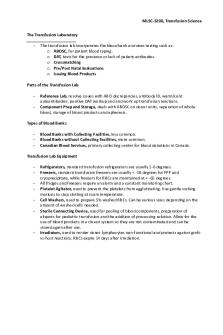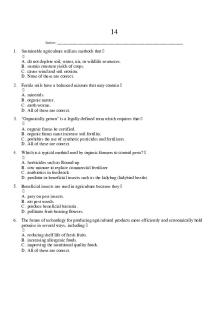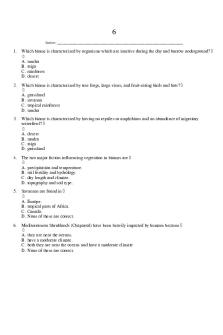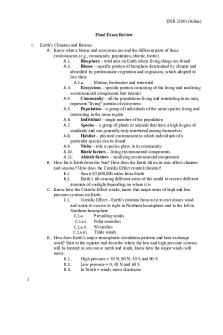13 - An intro to environmental science course PDF

| Title | 13 - An intro to environmental science course |
|---|---|
| Course | Environmental Science |
| Institution | American University of Sharjah |
| Pages | 33 |
| File Size | 286.8 KB |
| File Type | |
| Total Downloads | 103 |
| Total Views | 179 |
Summary
An intro to environmental science course...
Description
13 Student: ___________________________________________________________________________
1.
Which term describes the movement of large plates on the surface of the Earth? A. lithosphere B. abrasion C. plate tectonics D. mechanical weathering
2.
__________ increases the decomposition rate of organic matter. A. High rainfall B. Low rainfall C. Low temperatures D. High temperatures
3.
Which of the following is NOT a typical soil inhabitant? A. earthworm B. lichen C. bacteria D. nematodes
4.
In regions with _______, basic ions are leached from the soil and more acidic materials are left behind. A. high rainfall B. high temperatures C. low rainfall D. permafrost
5.
_________ is added to soils to make them less acidic. A. Manure B. Organic matter C. Lime D. Nitrogen
6.
Two processes which chemically alter parent material are A. oxidation and hydrolysis. B. decomposition and oxidation. C. hydrolysis and liming. D. freezing and thawing.
7.
Which soil profile contains material leached from other horizons? A. A B. B C. C D. D
8.
Soil compaction A. enhances plant growth. B. manages pests. C. allows roots to spread. D. reduces the amount of air, water, and space available to roots.
9.
Land has characteristics that influence how it can be used, including A. soil, climate, and degree of slope. B. crops, trees, and shrubs. C. houses, farms, and commercial buildings. D. None of these are correct.
10. Soil quality management components include A. adding massive nutrient loads. B. excessive tillage. C. enhancing organic matter. D. All of these are correct. 11. By avoiding excessive tillage, soil quality is enhanced by A. minimizing loss of organic matter. B. adding diverse crops. C. maximizing soil removal. D. All of these are correct. 12. Soil conservation or quality management practices include A. land use planning. B. building development codes. C. contour and strip farming. D. All of these are correct. 13. Which of the following do plants need to live? A. water B. carbon dioxide C. oxygen D. All of these are correct. 14. Soil building begins with the physical fragmentation of layers of rock known as A. layering of rock. B. parent material. C. syncline structures. D. fluvial overlay.
15. What is the name of the process in which rock combines with water molecules to form new compounds? A. aeration B. chemical weathering C. hydrolysis D. oxidation 16. What is the importance of humus? A. It supplies cadmium. B. It decreases pH. C. It allows seeds to germinate. D. It provides a habitat for invertebrates. 17. Organisms affect the soil in which of the following ways? A. by releasing nutrients B. by burrowing C. through decomposition D. All of these are correct. 18. Which of the following does NOT determine soil fertility? A. organic matter content B. diversity of invertebrates C. water content D. air spaces 19. Which of the following is NOT a physical process affecting break down of parent material? A. freezing and thawing B. glaciers C. drought D. flowing water 20. Which horizon has the highest amount of organic matter? A. A B. B C. C 21. Decaying organic material is called A. loam. B. humus. C. lichen. D. parent material. 22. What percent of the U.S. cropland requires no soil conservation practices? A. 2% B. 10% C. 30% D. 60%
23. Soil conservation practices are designed to A. increase productivity. B. increase the percentage of grasslands over forests. C. support international trade. D. minimize topsoil loss. 24. Soil erosion is linked to which of the following environmental issues? A. air pollution B. water pollution C. soil pollution D. greenhouse effect 25. The primary purpose of conservation tillage is to A. reduce the number of times a field is plowed. B. adjust abiotic conditions so insects cannot live. C. incorporate organic material into the soil. D. allow surface water to flow more evenly. 26. Which farming practice(s) reduce soil erosion? A. crop rotation B. contour farming and terracing C. avoiding use of strip farming D. allowing for surface runoff 27. Land unsuitable for crops may be used for which of the following? A. grazing B. recreation C. lumber D. All of these are correct. 28. Which country of the world has the greater percent of land suitable for agriculture? A. South Africa B. Japan C. Ethiopia D. United States 29. What region of the world has the highest percent of soil degraded by human activity? A. Africa B. Europe C. Asia D. South America
30. The major soil classification types in North America are A. grasslands, forests, and deserts. B. swamps, grasslands, and forests. C. forests, grasses, and beaches. D. mountains, rivers, and canyons. 31. Which of the following a typically a pioneer organism to colonize the surface of bare rocks? A. humus B. algae C. lichens D. fungi 32. Which of the following is NOT an example of an initiative instituted by the U.S. Government in the 1930s in response to the drought and soil depletion of the Great Plains? A. The U.S. Army Corp of Engineers B. The Drought Relief Services C. The Soil Conservation Services D. The Resettlement Administration Which of the following best matches the description? 33. The crust and solid outer mantle of the Earth. A. weathering B. parent material C. friable D. soil profile E. humus F. chemical weathering G. terrace H. soil structure I. mechanical weathering J. leaching K. contour farming L. loam M. horizon N. windbreak O. soil texture P. lithosphere Q. asthenosphere
34. A thin flowing layer of the Earth just below the mantle. A. weathering B. parent material C. friable D. soil profile E. humus F. chemical weathering G. terrace H. soil structure I. mechanical weathering J. leaching K. contour farming L. loam M. horizon N. windbreak O. soil texture P. lithosphere Q. asthenosphere 35. Physical and chemical breakdown of materials involved in the breakdown of parent material into soil. A. weathering B. parent material C. friable D. soil profile E. humus F. chemical weathering G. terrace H. soil structure I. mechanical weathering J. leaching K. contour farming L. loam M. horizon N. windbreak O. soil texture P. lithosphere Q. asthenosphere
36. The size of the particles that make up soil. A. weathering B. parent material C. friable D. soil profile E. humus F. chemical weathering G. terrace H. soil structure I. mechanical weathering J. leaching K. contour farming L. loam M. horizon N. windbreak O. soil texture P. lithosphere Q. asthenosphere 37. Ability of soil to crumble. A. weathering B. parent material C. friable D. soil profile E. humus F. chemical weathering G. terrace H. soil structure I. mechanical weathering J. leaching K. contour farming L. loam M. horizon N. windbreak O. soil texture P. lithosphere Q. asthenosphere
38. Soil organic matter. A. weathering B. parent material C. friable D. soil profile E. humus F. chemical weathering G. terrace H. soil structure I. mechanical weathering J. leaching K. contour farming L. loam M. horizon N. windbreak O. soil texture P. lithosphere Q. asthenosphere 39. Horizontal layer of soil. A. weathering B. parent material C. friable D. soil profile E. humus F. chemical weathering G. terrace H. soil structure I. mechanical weathering J. leaching K. contour farming L. loam M. horizon N. windbreak O. soil texture P. lithosphere Q. asthenosphere
40. Material that is weathered to become the mineral part of the soil. A. weathering B. parent material C. friable D. soil profile E. humus F. chemical weathering G. terrace H. soil structure I. mechanical weathering J. leaching K. contour farming L. loam M. horizon N. windbreak O. soil texture P. lithosphere Q. asthenosphere 41. The way soil particles clump together. A. weathering B. parent material C. friable D. soil profile E. humus F. chemical weathering G. terrace H. soil structure I. mechanical weathering J. leaching K. contour farming L. loam M. horizon N. windbreak O. soil texture P. lithosphere Q. asthenosphere
42. Series of layers seen as one digs down into soil. A. weathering B. parent material C. friable D. soil profile E. humus F. chemical weathering G. terrace H. soil structure I. mechanical weathering J. leaching K. contour farming L. loam M. horizon N. windbreak O. soil texture P. lithosphere Q. asthenosphere 43. Soil type with good drainage and texture that is ideal for agriculture. A. weathering B. parent material C. friable D. soil profile E. humus F. chemical weathering G. terrace H. soil structure I. mechanical weathering J. leaching K. contour farming L. loam M. horizon N. windbreak O. soil texture P. lithosphere Q. asthenosphere
44. Process of breaking up large particles by chemical reactions. A. weathering B. parent material C. friable D. soil profile E. humus F. chemical weathering G. terrace H. soil structure I. mechanical weathering J. leaching K. contour farming L. loam M. horizon N. windbreak O. soil texture P. lithosphere Q. asthenosphere 45. Movement of minerals from the A horizon to the B horizon. A. weathering B. parent material C. friable D. soil profile E. humus F. chemical weathering G. terrace H. soil structure I. mechanical weathering J. leaching K. contour farming L. loam M. horizon N. windbreak O. soil texture P. lithosphere Q. asthenosphere
46. Process of breaking up large particles by physical forces. A. weathering B. parent material C. friable D. soil profile E. humus F. chemical weathering G. terrace H. soil structure I. mechanical weathering J. leaching K. contour farming L. loam M. horizon N. windbreak O. soil texture P. lithosphere Q. asthenosphere 47. Planting of trees to prevent wind erosion. A. weathering B. parent material C. friable D. soil profile E. humus F. chemical weathering G. terrace H. soil structure I. mechanical weathering J. leaching K. contour farming L. loam M. horizon N. windbreak O. soil texture P. lithosphere Q. asthenosphere
48. Method of tilling and planting at right angles to the slope. A. weathering B. parent material C. friable D. soil profile E. humus F. chemical weathering G. terrace H. soil structure I. mechanical weathering J. leaching K. contour farming L. loam M. horizon N. windbreak O. soil texture P. lithosphere Q. asthenosphere 49. Level area constructed on steep slopes for agricultural purposes. A. weathering B. parent material C. friable D. soil profile E. humus F. chemical weathering G. terrace H. soil structure I. mechanical weathering J. leaching K. contour farming L. loam M. horizon N. windbreak O. soil texture P. lithosphere Q. asthenosphere 50. Soil is a mixture of minerals, organic material, living organisms, air, and water. True False 51. Oxidation and hydrolysis can chemically alter parent material. True False 52. The mineral portion of the soil consists of humus, duff, and the roots of plants. True False
53. Fragmentation of soil particles occurs from freezing and thawing of water within soil pores and cracks. True False 54. Soil structure refers to the way various soil particles clump together. True False 55. Most plants grow well in very acid soils. True False 56. Forest soils typically have a deep A horizon and shallow B horizon. True False 57. Desert soils have very poorly developed horizons. True False 58. Grassland soils usually have a shallow A horizon and a deep B horizon. True False 59. Strip farming is a type of soil conservation or quality management practice. True False 60. River bottoms and delta regions have a very deep topsoil layer. True False 61. Loam soil is primarily clay with small amounts of sand and silt. True False 62. Conservation tillage is an agricultural method that assures maximum water conservation. True False 63. Waterways with little vegetation generally increase erosion. True False 64. Misuse of land reduces its soil fertility and causes air- and water-quality problems. True False 65. Traditional landscaping maintenance practices that meet human needs and aesthetics often harm the environment. True False 66. Topsoil contains mineralized parent material and inorganic material. True False
67. Most roots grow down to the C horizon. True False 68. Ithaca College in New York and the University of Western Ontario instituted a green roof program as part of a campus sustainability initiative. True False 69. Depletion of soil fertility is a major cause of low per capita food production in Africa. True False 70. Geologic processes build and erode the Earth's surface. True False 71. An important function of soil is to buffer and detoxify chemicals. True False 72. Physical, chemical, and biological factors contribute to soil formation. True False 73. Humus is not important to soil fertility. True False 74. There is essentially no difference between soil texture and soil structure. True False 75. Terracing, waterways, and windbreaks can help reduce soil erosion. True False 76. Misuse of soil can reduce soil fertility. True False 77. Land that can not be cultivated will not be productive for other uses. True False 78. Soil quality management can enhance organic matter, manage pests, and prevent soil compaction. True False 79. By keeping the ground covered, bare soil will not be protected from wind and water erosion. True False
13 Key 1.
Which term describes the movement of large plates on the surface of the Earth? A. lithosphere B. abrasion C. plate tectonics D. mechanical weathering Enger - Chapter 13 #1
2.
__________ increases the decomposition rate of organic matter. A. High rainfall B. Low rainfall C. Low temperatures D. High temperatures Enger - Chapter 13 #2
3.
Which of the following is NOT a typical soil inhabitant? A. earthworm B. lichen C. bacteria D. nematodes Enger - Chapter 13 #3
4.
In regions with _______, basic ions are leached from the soil and more acidic materials are left behind. A. high rainfall B. high temperatures C. low rainfall D. permafrost Enger - Chapter 13 #4
5.
_________ is added to soils to make them less acidic. A. Manure B. Organic matter C. Lime D. Nitrogen Enger - Chapter 13 #5
6.
Two processes which chemically alter parent material are A. oxidation and hydrolysis. B. decomposition and oxidation. C. hydrolysis and liming. D. freezing and thawing. Enger - Chapter 13 #6
7.
Which soil profile contains material leached from other horizons? A. A B. B C. C D. D Enger - Chapter 13 #7
8.
Soil compaction A. enhances plant growth. B. manages pests. C. allows roots to spread. D. reduces the amount of air, water, and space available to roots. Enger - Chapter 13 #8
9.
Land has characteristics that influence how it can be used, including A. soil, climate, and degree of slope. B. crops, trees, and shrubs. C. houses, farms, and commercial buildings. D. None of these are correct. Enger - Chapter 13 #9
10.
Soil quality management components include A. adding massive nutrient loads. B. excessive tillage. C. enhancing organic matter. D. All of these are correct. Enger - Chapter 13 #10
11.
By avoiding excessive tillage, soil quality is enhanced by A. minimizing loss of organic matter. B. adding diverse crops. C. maximizing soil removal. D. All of these are correct. Enger - Chapter 13 #11
12.
Soil conservation or quality management practices include A. land use planning. B. building development codes. C. contour and strip farming. D. All of these are correct. Enger - Chapter 13 #12
13.
Which of the following do plants need to live? A. water B. carbon dioxide C. oxygen D. All of these are correct. Enger - Chapter 13 #13
14.
Soil building begins with the physical fragmentation of layers of rock known as A. layering of rock. B. parent material. C. syncline structures. D. fluvial overlay. Enger - Chapter 13 #14
15.
What is the name of the process in which rock combines with water molecules to form new compounds? A. aeration B. chemical weathering C. hydrolysis D. oxidation Enger - Chapter 13 #15
16.
What is the importance of humus? A. It supplies cadmium. B. It decreases pH. C. It allows seeds to germinate. D. It provides a habitat for invertebrates. Enger - Chapter 13 #16
17.
Organisms affect the soil in which of the following ways? A. by releasing nutrients B. by burrowing C. through decomposition D. All of these are correct. Enger - Chapter 13 #17
18.
Which of the following does NOT determine soil fertility? A. organic matter content B. diversity of invertebrates C. water content D. air spaces Enger - Chapter 13 #18
19.
Which of the following is NOT a physical process affecting break down of parent material? A. freezing and thawing B. glaciers C. drought D. flowing water Enger - Chapter 13 #19
20.
Which horizon has the highest amount of organic matter? A. A B. B C. C Enger - Chapter 13 #20
21.
Decaying organic material is called A. loam. B. humus. C. lichen. D. parent material. Enger - Chapter 13 #21
22.
What percent of the U.S. cropland requires no soil conservation practices? A. 2% B. 10% C. 30% D. 60% Enger - Chapter 13 #22
23.
Soil conservation practices are designed to A. increase productivity. B. increase the percentage of grasslands over forests. C. support international trade. D. minimize topsoil loss. Enger - Chapter 13 #23
24.
Soil erosion is linked to which of the following environmental issues? A. air pollution B. water pollution C. soil pollution D. greenhouse effect Enger - Chapter 13 #24
25.
The primary purpose of conservation tillage is to A. reduce the number of times a field is plowed. B. adjust abiotic conditions so insects cannot live. C. incorporate organic material into the soil. D. allow surface water to flow more evenly. Enger - Chapter 13 #25
26.
Which farming practice(s) reduce soil erosion? A. crop rotation B. contour farming and terracing C. avoiding use of strip farming D. allowing for surface runoff Enger - Chapter 13 #26
27.
Land unsuitable for crops may be used for which of the following? A. grazing B. recreation C. lumber D. All of these are correct. Enger - Chapter 13 #27
28.
Which country of the world has the greater percent of land suitable for agriculture? A. South Africa B. Japan C. Ethiopia D. United States Enger - Chapter 13 #28
29.
What region of the world has the highest percent of soil degraded by human activity? A. Africa B. Europe C. Asia D. South America Enger - Chapter 13 #29
30.
The major soil classification types in North America are A. grasslands, forests, and deserts. B. swamps, grasslands, and forests. C. forests, grasses, and beaches. D. mountains, rivers, and canyons. Enger - Chapter 13 #30
31.
Which of the following a typically a pioneer organism to colonize the surface of bare rocks? A. humus B. algae C. lichens D. fungi Enger - Chapter 13 #31
32.
Which of the following is NOT an example of an initiative instituted by the U.S. Government in the 1930s in response to the drought and soil depletion of the Great Plains? A. The U.S. Army Corp of Engineers B. The Dr...
Similar Free PDFs

Intro to Transfusion Science
- 3 Pages

Environmental Science
- 16 Pages

Intro to Psych Course Notes
- 44 Pages

BIO LAB Intro to Science
- 12 Pages

Environmental Science Module 1
- 4 Pages

Environmental Science and Engineering
- 109 Pages

Environmental Science Midterm Review
- 17 Pages
Popular Institutions
- Tinajero National High School - Annex
- Politeknik Caltex Riau
- Yokohama City University
- SGT University
- University of Al-Qadisiyah
- Divine Word College of Vigan
- Techniek College Rotterdam
- Universidade de Santiago
- Universiti Teknologi MARA Cawangan Johor Kampus Pasir Gudang
- Poltekkes Kemenkes Yogyakarta
- Baguio City National High School
- Colegio san marcos
- preparatoria uno
- Centro de Bachillerato Tecnológico Industrial y de Servicios No. 107
- Dalian Maritime University
- Quang Trung Secondary School
- Colegio Tecnológico en Informática
- Corporación Regional de Educación Superior
- Grupo CEDVA
- Dar Al Uloom University
- Centro de Estudios Preuniversitarios de la Universidad Nacional de Ingeniería
- 上智大学
- Aakash International School, Nuna Majara
- San Felipe Neri Catholic School
- Kang Chiao International School - New Taipei City
- Misamis Occidental National High School
- Institución Educativa Escuela Normal Juan Ladrilleros
- Kolehiyo ng Pantukan
- Batanes State College
- Instituto Continental
- Sekolah Menengah Kejuruan Kesehatan Kaltara (Tarakan)
- Colegio de La Inmaculada Concepcion - Cebu








